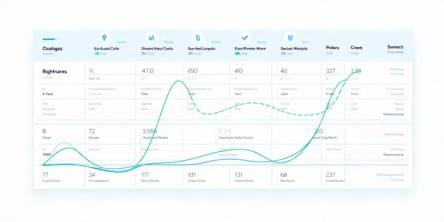Advantages of Using React.js for Developing Engaging Educational Applications

EdTech developers leverage modern technology to create immersive and engaging learning apps. A successful product relies on solid technology, including front-end frameworks like React.js, offering efficient development and incorporating cutting-edge features like gamification and voice recognition for a standout user experience in the education industry.
It is a dynamic and efficient JavaScript library that has emerged as a powerful tool for developing cutting-edge education applications. Its flexibility, speed, and extensive ecosystem offer many benefits that revolutionize how educational apps are created and experienced.
In this blog, I will explore the advantages of using ReactJS for educational application development while shedding light on how it drives innovation and enhances the learning experience for students and educators.
What is React.js?
React.js, or React, is an open-source front-end JavaScript library that uses components to build interactive and dynamic user interfaces for web applications. It reduces the development time while maintaining the quality of the final product. It is a declarative, efficient, and flexible JavaScript library for building reusable UI components. React.js uses a virtual DOM (Document Object Model) that updates only those parts of the UI that change, thereby improving the performance and efficiency of web applications. It also supports JSX, an XML/HTML-like extension to JavaScript that allows developers to write HTML in JavaScript code.
Let's examine some reasons that make React.js an ideal choice for development in education applications.
Status of React.js in 2025
React.js has been around since 2013 and has gained much popularity among developers and users. Because of its many features, including a new one called Parallel Mode, which allows developers to create components that can render and update asynchronously, it seems that React.js will continue to be one of the leading front-end development technologies of 2025, as it improves the performance and efficiency of applications.
Benefits Of Using React.js To Create Modern, Scalable Education Apps:-
- Reusable components: React helps create interactive and dynamic web applications for education. React uses a component-based structure, allowing developers to write independent code that can be reused and combined as needed. This helps reduce the development time and speeds up the process. Each component of React has its logic, which helps developers create consistent and appealing user interfaces for the education application. It also makes maintaining and expanding the codebase easier as the app grows.
- Virtual DOM: A virtual DOM or Document Object Model is a lightweight JavaScript representing an educational web application's state. Virtual DOM is faster to update than the actual DOM, which is the HTML structure of the web page. React.js supports virtual DOM, helping speed up the loading and rendering of web pages by updating only the parts that change and removing the need to load the entire HTML structure. This feature allows users to have a smooth and uninterrupted interaction with the app, even when the app is updating.
- React Hooks: Hooks were introduced in the React 16.8 update and can be seen as functions that latch onto the React state from function components. These functions enable developers to use the many features of React libraries, such as state, and lifecycle methods in functional components without writing a class and increase the app's readability, reusability and testability.
- SEO friendly: Search engine optimization is essential for attracting and retaining users for web resources and boosting online education businesses. React.js helps enable server-side rendering (SSR), which helps web applications rank higher and be more visible on search engines. SSR allows search engines to access and index the web application connection without executing the JavaScript first.
- Flexibility and compatibility: Reach.js allows developers to develop applications that can be used across multiple platforms and browsers. It's almost like developing a universal solution that reduces time-to-launch. It can be used to create applications of any size and complexity because of its scalable and versatile nature. React enables linking with other tools and frameworks, allowing developers to create apps offering multiple features.
- Easy migration: React.js allows developers to build small JavaScript components that can be embedded in a web page. This feature makes switching to React.js from other JavaScript frameworks more convenient, which is why many businesses require React.js development services. React.js also works well with existing frameworks that let developers integrate React.js code in applications, affecting their performance.
- Fast refresh: React quick refresh is a feature that allows developers to update and re-render only those components that have changed without reloading the entire app. This feature also keeps the component state intact, so developers don't have to recreate the same situation manually. This feature enables faster and smoother feedback loops between making changes and seeing the results, which improves the developer experience.
Conclusion
React.js is an excellent option for educational application development, as it provides many benefits regarding functionality, performance, scalability, and developer experience. Institutions can partner with a company offering React.js development services to create high-quality educational applications.
Similar Articles
Food delivery applications, including Uber Eats, DoorDash, Zomato, Swiggy, and Grubhub, generate large volumes of valuable data.
Modern businesses are drowning in communication overload, and much of that burden stems from outdated tools that simply can’t keep up
Building lending software isn’t just a technical project—it’s a business decision. Whether you're a fintech founder or part of a traditional lending institution trying to go digital, three questions will shape everything that follows
Learn why robust security is crucial for super app development. Explore key strategies and best practices for mobile app development security.
Walkie-talkies with an extensive reception capacity have changed significantly when it comes to portable communication by displaying cutting-edge features with seamless connectivity that covers more than just the state
USB-C technology has revolutionized the way we charge our devices, offering faster charging speeds, higher power delivery, and universal compatibility across multiple devices
Discover expert mobile app development strategies to create a viral app that attracts users and boosts engagement
Optimize app localization for iOS users across the EU with language, cultural, and regulatory adaptations. Engage users and boost retention with these tips!
Discover the top 10 mobile app development trends of 2024! Explore 5G, AI, AR/VR, blockchain, and more to stay ahead in the ever-evolving app development landscape.









